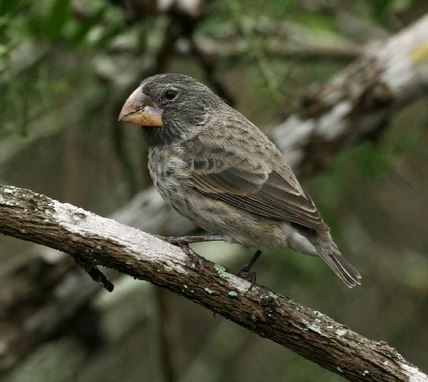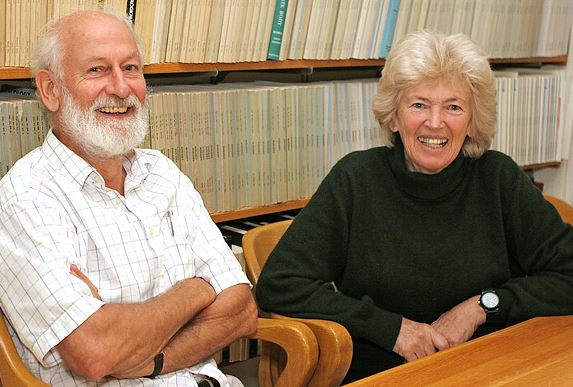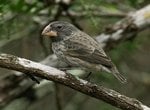American and Swedish scientists have identified a gene that influenced the beak shape of Darwin’s finches, also known as Galápagos finches, which evolved from a common ancestor over one million years ago.
The researchers, from Uppsala University in Sweden and Princeton University in the US, say their study illustrates the genetic foundation of evolution, including how genes flow between species, and how different version of a gene with one species can contribute to the formation of a completely new species.
The study has been published in the academic journal Nature (citation below) on February 11, just one day before Charles Darwin’s birthday. He studied the finches during his voyage in 1835, that would lead him to publish the seminal work on evolution – “On the Origin of Species” – in 1859.

Large ground finch (Geospiza magnirostris).
Peter Grant, Princeton’s Class of 1877 Professor of Zoology, Emeritus, and a professor of ecology and evolutionary biology, emeritus, said:
“We now know more about the genetic basis for our evolutionary studies, and this is a highly satisfactory, very exciting discovery after all these years.”
Along with his wife, B Rosemary Grant, a senior biologist in ecology and evolutionary biology, they have studied the finches for forty years on the rocky, arid islands of Daphne Major and Genovesa in the Galápagos archipelago.
Evolution occurs haphazardly
This latest study shows how evolution occurs in spurts and starts, a series of disordered steps, with several opportunities for genes to spread in different species and create new lineages.
Under the right conditions, for example, when a new lineage is isolated from the original population and different genes are accumulated, an entirely new species can eventually evolve.
The Swedish scientists worked with DNA samples collected by the Grants and identified the gene that influenced the finch’s beak shape by comparing the genomes of 120 birds. They were all members of 15 species known as “Darwin’s finches”.
They identified a DNA stretch that looked different in the species with blunt beaks, such as Geospiza magnirostris (large ground finch) compared to those with pointed beaks, such as Geospiza conirostris (large cactus finch).
The scientists found a gene known as ALX1 within that stretch of DNA, which had previously been linked to the formation of facial features in mice and humans. Mutations that activate this gene can trigger severe birth defects in human babies.
Lead researcher Leif Andersson, a professor of functional genomics at Uppsala University, the Swedish University of Agricultural Sciences, and Texas A&M University, said:
“This is an interesting example where mild mutations in a gene that is critical for normal development leads to phenotypic [observable] evolution.”

Peter Grant and B. Rosemary Grant (Image: Princeton University)
Genes vary within the same species
Prof. Andersson said that the most interesting and exciting find was that the gene also varied among individual birds of the same species. For example, the G. fortis (the medium ground finch) species includes some birds with pointed beaks and others with blunt ones.
Their finding is significant because it shows us how evolution can occur, Peter Grant explained. Within a species, when some birds have a trait that helps them survive – such as a blunt beak that makes it easier to crack open seed coverings – they will pass on that trait’s genes to their offspring, while the other birds with pointed beaks will have perished.
Prof. Grant said “This is the genetic variation upon which natural selection can work.”
The size and shape of a finch’s beak is crucial for its survival on the islands, where extreme droughts, volcanic activity and El Niño-driven rains are common. The birds use their beaks as tools to pry insects from twigs, obtain nectar from cactus flowers, and crack open the hard and woody outer coverings of seeds.
During a drought, a bird that can obtain food from several different sources is more likely to survive, unlike other birds.
Over the past forty years, the Grants and their colleagues have found that beak size and shape played an important role in the evolution of finch species through natural selection when Daphne Major was stricken with droughts in 1977, 1985 and 2004.
Ms. Grant said:
“Now we have a genetic underpinning of something we have seen three times during the last 40 years.”
The study also provided additional data on how genes are transferred from one species to another when birds from two closely-related species mate. Although in most species the offspring of parents from different species are sterile, this is not the case with the Galápagos finches, where the offspring can mate with either of the two parental species.
Their chicks will identify with one or other species through appearance and song, but they will carry the genes from both parents.
Via this process, known as introgression or gene flow, genetic material can move from one species to another and contribute to the development of new species.
While the Grants have shown that over the past 40 years gene flow has occurred in the finches of Daphne Major, this latest study found compelling evidence of gene flow spanning the last 1 million years among the birds that have lived in the archipelago.
They say the findings have helped them update their understanding of how the lineages diverged over time.
Prof. Grant said:
“We’ve been able to get a much more confident estimate, of which species are old and which are young, and the time course over which evolution happened.”
Citation: “Evolution of Darwin’s finches and their beaks revealed by genome sequencing,” Sangeet Lamichhaney, Jonas Berglund, Markus Sällman Almén, Khurram Maqbool, Manfred Grabherr, Alvaro Martinez-Barrio, Marta Promerová, Carl-Johan Rubin, Chao Wang, Neda Zamani, B. Rosemary Grant, Peter R. Grant, Matthew T. Webster & Leif Andersson. Nature (2015). Published Feb 11, 2015. doi:10.1038/nature14181.

